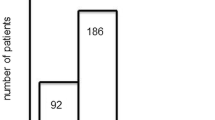Summary
In a prospective study 222 sera from 56 patients with systemic lupus erythematosus (SLE) were tested for antibodies to poly(A), poly dAT and histones using enzyme-linked immunosorbent assay (ELISA). Patients with active disease had significantly more often antibodies to poly(A), poly dAT and histones than patients with inactive disease. There was a positive correlation between the activity score of the disease and the levels of poly(A)-antibodies of IgG and IgM class, poly dAT-antibodies and antibodies to histones.
Patients with SLE-nephritis had a higher level of poly dAT and IgG class poly(A) antibodies than patients without nephritis. Interestingly, patients with an SLE-nephritis had lower levels of IgM-poly(A)-antibodies than those without nephritis. Attempts to use the ELISAs in predicting the SLE exacerbations were unsuccessful. However, the assays can be used as parameters in the estimation of the disease activity.
Similar content being viewed by others
References
Hughes GRW (1979) Systemic lupus erythematosus: treatment and prognosis. Br Med J 2:1019–1022
Morrow WJW, Isenberg DA, Todd-Pokropek A, Parry HF, Snaith ML (1982) Useful laboratory measurements in the management of systemic lupus erythematosus. Q J Med 202:125–138
Koffler D, Agnello V, Kunkel HG (1974) Polynucleotide immune complexes in serum and glomeruli of patients with systemic lupus erythematosus. Am J Pathol 74:109–124
Winfield JB, Faiferman I, Koffler D (1977) Avidity of anti-DNA antibodies in serum and IgG glomerular eluates from patients with systemic lupus erythematosus. J Clin Invest 59: 90–96
Alarcón-Segovia D, Diaz-Jouanen E (1980) Lupus subsets: relationship to genetic and environmental factors. Semin Arthritis Rheum 10:18–24
Gripenberg M, Piirainen H, Linder E (1981) Antibodies against polyriboadenylic acid in systemic lupus erythematosus and rheumatoid arthritis demonstrated by ELISA. Scand J Rheumatol 10:33–37
Lightfoot RW, Redecha PB, Levesanos N (1975) Longitudinal studies of anti-DNA antibody levels in SLE. Scand J Rheumatol (Suppl) 11:52–58
Davis P, Makinen D (1980) Antibody to synthetic poly dAT: correlation with antibody to native DNA and specifity for SLE. J Clin Pathol 33:648–652
Fishbein E, Alarcón-Segovia D, Vega JM (1979) Antibodies to histones in systemic lupus erythematosus. Clin Exp Immunol 36:145–150
Fritzler M, Ryan P, Kinsella D (1982) Clinical features of systemic lupus erythematosus patients with antihistone antibodies. J Rheumatol 9:46–51
Helve T, Kurki P, Teppo A-M, Wegelius O (1983) DNA antibodies and complement in SLE patients: a follow-up study. Rheumatol Int 3:129–132
Cohen AS, Reynolds WE, Franklin EC, Kulka JP, Ropes MW, Shulman LE, Wallace SL (1971) Preliminary criteria for the classification of systemic lupus erythematosus. Bull Rheum Dis 21:643–648
Gripenberg M, Helve T, Kurki P, Virtanen I (1982) Anti-histone antibodies in rheumatic diseases determined by ELISA. Scand J Rheumatol (Suppl) 45:14 (Abstr)
Gripenberg M, Linder E, Kurki P, Engwall E (1978) A solid phase enzyme-linked immunosorbent assay (ELISA) for the demonstration of antibodies against denatured, single-stranded DNA in patient sera. Scand J Immunol 7:151–157
Klotz JL, Minami RM, Teplitz RL (1979) An enzyme linked immunosorbent assay for antibodies to native and denatured DNA. J Immunol Methods 29:155–165
Stokes RP, Cordwell A, Thompson RA (1982) A simple, rapid ELISA method for the detection of DNA antibodies. J Clin Pathol 35:566–573
Eaton RB, Schneider G, Schur PH (1983) Enzyme immunoassay for antibodies to native DNA. Specificity and quality of antibodies. Arthritis Rheum 26:52–62
Labrousse H, Tron F, Avrameas S, Bach JF (1980) Direct evaluation of class specific anti-DNA antibodies by an immunoenzymatic technique. J Clin Lab Immunol 3:191–195
Helve T, Teppo A-M, Kurki P, Wegelius O (1982) Circulating DNA-antibodies in systemic lupus erythematosus. Rheumatol Int 2:103–106
Feldman MD, Huston DP, Karsh J, Balow JE, Klima E, Steinberg AD (1982) Correlation of serum IgG, IgM and antinative-DNA antibodies with renal and clinical indexes of activity in systemic lupus erythematosus. J Rheumatol 9: 52–58
Roitt IM, Male DK, Cooke A, Lydyard PM (1983) Idiotypes and autoimmunity. Springer Semin Immunopathol 6: 51–66
Gloud M, Ait Kaci M, Monier JC (1982) Histone antibodies in systemic lupus erythematosus a possible diagnostic tool. Arthritis Rheum 25:407–413
Author information
Authors and Affiliations
Rights and permissions
About this article
Cite this article
Helve, T., Gripenberg, M., Kurki, P. et al. Enzyme-linked immunosorbent assays for antibodies to poly(A), poly dAT and histones: possibly useful tools for the evaluation of prognosis and disease activity in systemic lupus erythematosus. Rheumatol Int 4, 75–78 (1984). https://doi.org/10.1007/BF00541200
Received:
Accepted:
Issue Date:
DOI: https://doi.org/10.1007/BF00541200




